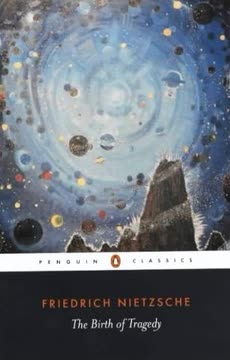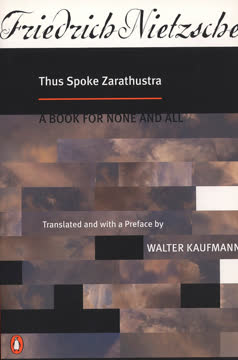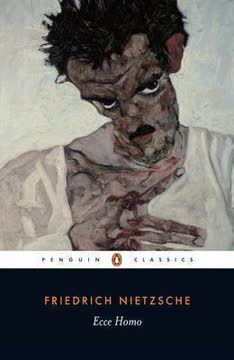Key Takeaways
1. Art Arises from the Tension Between Apollo and Dionysus
The continuous evolution of art is bound up with the duality of the Apolline and the Dionysiac in much the same way as reproduction depends on there being two sexes which co-exist in a state of perpetual conflict interrupted only occasionally by periods of reconciliation.
Two opposing forces. Nietzsche posits that art is born from the interplay between two fundamental forces: the Apolline and the Dionysiac. The Apolline represents order, reason, and individual form, akin to the clarity of dreams. The Dionysiac, on the other hand, embodies chaos, instinct, and the dissolution of the individual, similar to the ecstatic experience of intoxication.
Perpetual conflict. These forces are not harmonious but exist in a state of constant tension and struggle. This conflict is essential for artistic creation, as it drives the evolution of new forms and expressions. Without the Apollonian, the Dionysian would be formless and destructive. Without the Dionysian, the Apollonian would be sterile and lifeless.
Attic tragedy. The highest form of art, according to Nietzsche, is Attic tragedy, which achieves a perfect synthesis of the Apolline and the Dionysiac. In tragedy, the rational structure of the plot and the individual characters (Apolline) are combined with the emotional intensity and the dissolution of the self in the chorus (Dionysiac).
2. Dreams and Intoxication as Pathways to Artistic Creation
Every human being is fully an artist when creating the worlds of dream, and the lovely semblance of dream is the precondition of all the arts of image-making, including, as we shall see, an important half of poetry.
Dream state. The Apolline finds its purest expression in the dream state. In dreams, we create vivid and coherent worlds, filled with images and narratives that are both familiar and strange. This ability to generate semblance is the foundation of all visual arts, from sculpture to painting.
Intoxication state. The Dionysiac, conversely, is rooted in the experience of intoxication. This state transcends the boundaries of the individual, dissolving the self into a primal unity with nature. Music, dance, and ecstatic rituals are the primary expressions of the Dionysiac.
Artistic inspiration. Both dreams and intoxication serve as sources of artistic inspiration. The Apolline artist draws on the clarity and form of dreams, while the Dionysiac artist taps into the raw energy and emotional intensity of intoxication.
3. Greek Tragedy as a Synthesis of Apolline and Dionysiac Elements
Attic tragedy.
Apolline and Dionysiac in equal measure. Nietzsche argues that Greek tragedy represents the perfect fusion of the Apolline and Dionysiac. The tragic hero, a distinct individual with a clear fate (Apolline), is ultimately destroyed, revealing the underlying chaos and unity of existence (Dionysiac).
Myth and music. Tragedy combines the visual spectacle of the stage (Apolline) with the emotional power of music (Dionysiac). The myth provides a framework for the action, while the music expresses the underlying emotions and metaphysical truths.
Metaphysical solace. Tragedy offers a unique form of "metaphysical solace" by allowing us to confront the suffering and absurdity of existence while simultaneously affirming the eternal power of life. This solace is achieved through the interplay of Apolline semblance and Dionysiac wisdom.
4. The Chorus as the Embodiment of Dionysiac Wisdom
The chorus of Greek tragedy, the symbol of the entire mass of those affected by Dionysiac excitement, is fully explained by our understanding of the matter.
The chorus is key. The chorus is not merely a group of commentators but the very heart of tragedy. It represents the collective voice of the Dionysiac, expressing the primal emotions and insights that underlie the action on stage.
Dionysiac mass. The chorus embodies the dissolution of the individual into the collective, reflecting the ecstatic experience of Dionysiac rituals. Through song and dance, the chorus conveys the underlying unity of all things.
Wisdom and truth. The chorus is not only a source of emotional intensity but also a vehicle for profound wisdom. It speaks of the terrors and absurdities of existence, but also of the eternal power of life and the possibility of redemption.
5. Socrates and the Dawn of Theoretical Culture
In order to be beautiful, everything must be reasonable.
Socrates as a turning point. Nietzsche identifies Socrates as a pivotal figure in the decline of tragedy. Socrates represents the rise of reason, logic, and theoretical knowledge, which he sees as fundamentally opposed to the artistic and intuitive spirit of tragedy.
Reason over instinct. Socrates believed that knowledge and virtue were inseparable, and that reason could solve all problems. This optimistic faith in reason led him to reject the irrationality and emotional intensity of tragedy.
The death of myth. Socratic rationalism undermined the power of myth, which Nietzsche sees as essential for a healthy culture. By subjecting everything to logical scrutiny, Socrates destroyed the imaginative and symbolic foundations of Greek society.
6. Euripides and the Rationalization of Tragedy
Euripides brought the spectator on to the stage.
Euripides as a follower. Euripides, the playwright, is portrayed as a disciple of Socrates, who sought to rationalize tragedy and make it more palatable to the intellect. He replaced the mythical heroes of Aeschylus and Sophocles with more realistic and relatable characters.
Emphasis on realism. Euripides prioritized psychological realism and moral clarity over the symbolic depth and metaphysical insights of earlier tragedy. He sought to appeal to the audience's reason and emotions, rather than their sense of wonder and awe.
Decline of the chorus. Euripides diminished the role of the chorus, reducing it from a central participant in the drama to a mere commentator. This further weakened the Dionysiac element in tragedy and paved the way for its eventual demise.
7. The Death of Tragedy and the Rise of Aesthetic Socratism
Tragedy is dead! And with it we have lost poetry itself!
Suicide of tragedy. Nietzsche argues that tragedy did not simply fade away but committed suicide, driven to its destruction by the forces of rationalism and aesthetic Socratism. The emphasis on reason and morality ultimately suffocated the artistic spirit of tragedy.
New Attic Comedy. The successor to tragedy was the New Attic Comedy, a form of drama that focused on everyday life, witty dialogue, and stock characters. This genre lacked the depth and metaphysical significance of tragedy.
Alexandrian culture. The death of tragedy marked the triumph of Alexandrian culture, characterized by its emphasis on knowledge, reason, and superficial entertainment. This culture, Nietzsche argues, is fundamentally hostile to art and life.
8. The Rebirth of Tragedy from the Spirit of Music
Only as an aesthetic phenomenon are existence and the world eternally justified.
Music as a source. Nietzsche expresses hope for a rebirth of tragedy from the spirit of music, particularly German music from Bach to Wagner. He sees in this music a rediscovery of the Dionysiac power that can revitalize art and culture.
Beyond Socratism. The rebirth of tragedy requires a rejection of the Socratic emphasis on reason and a return to a more intuitive and artistic way of understanding the world. This involves embracing the irrational, the emotional, and the mythical.
The music-making Socrates. Nietzsche envisions a new kind of Socrates, one who combines the power of reason with the creative energy of art. This "music-making Socrates" would be a symbol of the synthesis of Apolline and Dionysiac forces.
9. The Tragic Myth as a Metaphysical Supplement to Reality
Only as an aesthetic phenomenon can the world be justified.
Myth and reality. The tragic myth is not merely a story but a metaphysical supplement to reality. It provides a framework for understanding the suffering and absurdity of existence, while simultaneously affirming the eternal power of life.
Dionysiac wisdom. The tragic myth is a vehicle for conveying Dionysiac wisdom, which recognizes the interconnectedness of all things and the cyclical nature of creation and destruction. This wisdom is often expressed through symbols and metaphors.
Apolline artistry. The tragic myth is shaped and refined by Apolline artistry, which provides structure, clarity, and beauty. This combination of Dionysiac content and Apolline form is essential for the creation of a truly powerful and meaningful work of art.
10. The Dangers of Alexandrian Culture and the Need for Myth
Without myth, however, all cultures lose their healthy, creative, natural energy.
Alexandrian culture is a threat. Nietzsche warns against the dangers of Alexandrian culture, which he sees as a force of disintegration and decay. This culture, with its emphasis on reason and knowledge, undermines the power of myth and weakens the foundations of society.
The loss of myth. The loss of myth leads to a sense of homelessness, alienation, and a restless search for meaning. Modern culture, Nietzsche argues, is characterized by this lack of a unifying narrative and a deep sense of dissatisfaction.
The German spirit. Nietzsche expresses hope that the German spirit, with its inherent Dionysiac strength, can resist the forces of Alexandrian culture and create a new and vital form of art and culture. This requires a return to myth and a rediscovery of the tragic vision.
Last updated:
FAQ
What is The Birth of Tragedy by Friedrich Nietzsche about?
- Dual artistic origins: The book explores the origins of Greek tragedy as a synthesis of two opposing artistic drives: the Apolline (order, individuation) and the Dionysiac (chaos, unity).
- Cultural and philosophical critique: Nietzsche uses Greek tragedy to critique modern culture, especially the dominance of rationalism and the decline of myth.
- Tragic affirmation: He argues that tragedy provides a way to affirm life despite its inherent suffering, offering aesthetic consolation.
- Metaphysical exploration: The work delves into deep questions about existence, art, and the human condition.
Why should I read The Birth of Tragedy by Friedrich Nietzsche?
- Foundational philosophical work: It is Nietzsche’s first major book, introducing key concepts that shaped his later thought and modern aesthetics.
- Cultural insight: The book offers a profound critique of rationalism and modernity, challenging readers to reconsider the role of art and myth in life.
- Unique perspective: Nietzsche blends philosophy, philology, and art criticism in a poetic style, providing a fresh view on pessimism, affirmation, and culture.
- Influence on later thinkers: The ideas in this book have had a lasting impact on philosophy, literature, and the arts.
What are the key takeaways from The Birth of Tragedy by Friedrich Nietzsche?
- Apolline and Dionysiac duality: The highest art arises from the creative tension between order (Apollo) and chaos (Dionysos).
- Critique of rationalism: Socratic rationalism led to the decline of tragedy and myth, resulting in cultural crisis.
- Art as life-affirming: Tragedy allows humans to confront suffering and affirm life through aesthetic experience.
- Role of myth and music: Myth and music are essential for cultural health and metaphysical understanding.
What are the Apolline and Dionysiac principles in The Birth of Tragedy by Friedrich Nietzsche?
- Apolline principle: Represents order, clarity, individuation, and beautiful semblance, associated with Apollo and the plastic arts.
- Dionysiac principle: Embodies chaos, ecstasy, dissolution of individuality, and primal unity, linked to Dionysos and music.
- Creative tension: Greek tragedy emerges from the interplay and reconciliation of these two forces.
- Metaphorical significance: The opposition symbolizes the human condition and the mediation between appearance and reality.
How does Friedrich Nietzsche describe the origin and function of Greek tragedy in The Birth of Tragedy?
- Dionysiac choral roots: Tragedy originated from the Dionysiac chorus, expressing collective ecstasy and unity with nature.
- Apolline mediation: The introduction of structured dialogue and individual actors brought order and meaning to the Dionysiac experience.
- Metaphysical role: Tragedy reveals the tension between individuality and unity, offering aesthetic consolation for life’s suffering.
- Cultural reflection: The fusion of these elements reflects the Greek spirit and their approach to existence.
How does Friedrich Nietzsche critique Socratic rationalism in The Birth of Tragedy?
- Socratic dominance: Socrates represents the rise of reason and knowledge over instinct and myth, disrupting the balance of artistic forces.
- Destruction of tragedy: Rationalism led to the decline of tragic art by replacing mythic insight with abstract, theoretical knowledge.
- Cultural consequences: The loss of myth and tragic spirit resulted in cultural sterility and a crisis of meaning.
- Ambivalent legacy: Nietzsche acknowledges Socrates’ influence but sees his optimism as ultimately life-denying.
What role does music play in Nietzsche’s theory of tragedy in The Birth of Tragedy?
- Dionysiac expression: Music is the purest form of the Dionysiac principle, directly expressing the metaphysical essence of existence.
- Metaphysical access: Music provides a non-representational access to reality, bypassing images and concepts.
- Foundation of myth: Music gives birth to myth and underpins the emotional power of tragedy.
- Healing and consolation: Through music, tragedy offers solace and enables the audience to endure suffering.
How does Friedrich Nietzsche explain the decline and potential rebirth of tragedy and myth in The Birth of Tragedy?
- Decline through rationalism: Socratic emphasis on reason undermined the Dionysiac spirit, leading to the destruction of myth and tragedy.
- Modern cultural crisis: The loss of myth results in cultural fragmentation and a restless search for meaning.
- Signs of renewal: Nietzsche sees hope in the revival of the Dionysiac spirit in German music and philosophy, especially in Wagner and Schopenhauer.
- Call for new culture: He advocates for a new tragic culture that reconciles wisdom and suffering through art.
What is Nietzsche’s view on pessimism and affirmation in The Birth of Tragedy?
- Pessimism of strength: Nietzsche distinguishes between a life-denying pessimism and a life-affirming, tragic pessimism.
- Tragic affirmation: Tragedy enables humans to face suffering and still affirm life through aesthetic experience.
- Rejection of optimism: He criticizes naive optimism, arguing that true affirmation comes from embracing life’s tragic nature.
- Aesthetic justification: Art, especially tragedy, justifies existence by transforming suffering into beauty.
How does Friedrich Nietzsche relate The Birth of Tragedy to Richard Wagner and his music?
- Wagnerian influence: Nietzsche dedicates the book to Wagner, seeing his music-dramas as a modern revival of the tragic synthesis.
- Model for renewal: Wagner’s art is presented as a way to restore the Dionysiac spirit and heal modern culture.
- Complex relationship: Although Nietzsche later criticizes Wagner, in this work he celebrates Wagner’s role in cultural renewal.
- Music as salvation: Wagner’s music is seen as capable of reawakening the tragic, mythic dimension of art.
What is the significance of the Dionysiac chorus and the satyr in The Birth of Tragedy by Friedrich Nietzsche?
- Symbol of nature: The Dionysiac chorus, often represented by satyrs, embodies primal forces and ecstatic unity.
- Artistic foundation: The chorus is the original form of tragedy, expressing the Dionysiac experience before Apolline elements were added.
- Cultural metaphor: The satyr chorus represents the tension between nature and culture, and the possibility of artistic redemption through suffering.
- Protective function: It serves as a living wall preserving the purity of tragic art.
What is Nietzsche’s critique of opera in The Birth of Tragedy?
- Hybrid art form: Nietzsche sees opera as a product of layman’s aesthetics, mixing music and word with the word dominating.
- Loss of Dionysiac power: Opera reduces music to mere entertainment, losing its myth-creating and metaphysical function.
- Optimistic illusion: Opera embodies an idyllic, naive optimism about human nature, contrary to the tragic spirit.
- Reflection of culture: It reflects the theoretical optimism and cheerfulness of Alexandrian culture, which Nietzsche critiques.
Review Summary
The Birth of Tragedy is Nietzsche's first published work, exploring the origins of Greek tragedy through the interplay of Apollonian and Dionysian forces. While some readers found it dense and challenging, others praised its insights into art, culture, and human nature. Nietzsche critiques Socratic rationalism and advocates for a return to tragic wisdom. The book's style is often described as passionate and poetic, though occasionally unclear. Many reviewers noted its importance in understanding Nietzsche's early philosophical development, despite its flaws.
Similar Books
Download PDF
Download EPUB
.epub digital book format is ideal for reading ebooks on phones, tablets, and e-readers.























